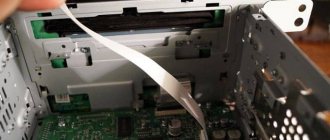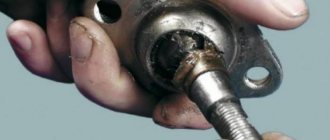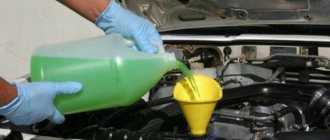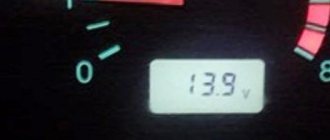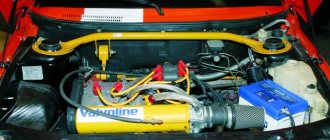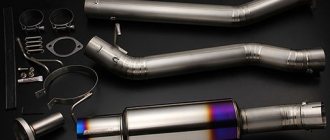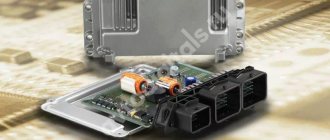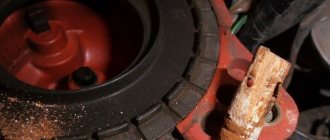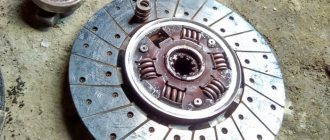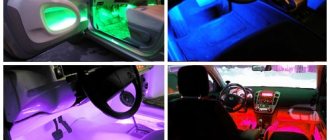When operating a gasoline or diesel engine, the driver may encounter the fact that when pressing the gas, the engine does not gain speed. Note that after installing LPG on a car, a problem often arises when the engine does not pick up speed on gas, although the car drives normally on gasoline. Malfunctions of various kinds can be hidden either in fairly simple things or indicate the need for serious repair of the internal combustion engine. Next, we will look at why a diesel engine does not pick up speed or a gasoline engine refuses to spin up.
We also recommend reading the article about why the engine loses power. From this article you will learn about the main reasons for the loss of power of the power unit.
Environmental influence
Ambient temperature can reduce the vehicle's traction. This is due to the concentration of oxygen in the atmospheric air.
- When the temperature rises from zero to thirty degrees, the amount of oxygen decreases by about 20%, therefore the efficiency of the motor decreases.
- This is especially noticeable in the mountains: every 100 meters when you rise to a height, the power of your car will decrease by 1%.
- This statement is especially true for 3 or 4 cylinder engines with a volume of up to one and a half liters.
High humidity also reduces engine performance. This effect is achieved due to the displacement of oxygen by water vapor, which, accordingly, reduces the engine thrust. In dry and cool weather the car drives more vigorously. But, as a rule, such changes are insignificant, so not every driver will be able to notice them.
Motor problems
Critical wear of the cylinder-piston group of the power unit also leads to a decrease in power. There are other reasons why the engine revs poorly:
- valve burnout in one or more cylinders;
- lack of compression or its drop below the permissible level;
- incorrect adjustment of thermal clearances between valve stems and rocker arms;
- problems with the timing belt or chain drive.
Most of the listed malfunctions are detected by measuring compression. A burnt valve does not completely seat in its seat, which is why the pressure in this cylinder drops to 2-3 bar, and sometimes to zero. A general decrease in compression in all cylinders to 9 bar or less indicates “bad” piston rings.
Advice. Before announcing the verdict on the cylinder-piston group, it is worth checking the thermal clearances with a feeler gauge. If some “specialist” recently made an incorrect adjustment and tightened the valves, then the compression will also decrease.
Similar errors occur when replacing a timing chain or belt, when the marks shift by 1 tooth. The consequences are violation of valve timing and loss of power, plus unstable engine operation. Careless drivers who do not take care of their own cars encounter a similar effect: due to wear, the chain (belt) stretches greatly and jumps 1 tooth on the camshaft gear.
Too high oil consumption, penetrating into the combustion chambers through valve seals, also worsens the operating conditions of the power unit . From the inside, the chamber walls and spark plug electrodes become covered with soot, and the piston rings become coked and stuck. A sure sign of a malfunction is clouds of bluish smoke from the exhaust pipe.
Fuel quality
A mismatch in octane rating for a car's engine can result in slow acceleration. Outright counterfeit products, instead of high-quality gasoline, immediately make themselves known. The car may not start immediately, or may not start at all.
- If the car does start, in addition to reduced power, signs of detonation may appear, that is, when the fuel ignites before the required time.
- This will be expressed in a characteristic tapping sound when you press the gas pedal.
- In this case, you can either add higher quality fuel or completely replace the fuel in the tank.
If the problem remains even after draining the counterfeit, you need to take the car to a car dealership to completely flush the car's power system.
Injection cars
If your car uses the injection principle, then you can check for faults using special diagnostic equipment. This is available at any service station that respects its reputation. Stuttering and jerking during acceleration can be associated with insufficient fuel pressure, failure of air flow sensors and throttle position sensors.
But if the movement is not accelerating, the jerking may most likely be due to the fact that the ignition system is acting up. In this case, it is also recommended to carry out computer diagnostics of the components and, if necessary, repair the ignition. If troubles arise along the way, you can independently check the contacts with the wires on the ignition coils. Also, when starting the engine with the hood open, listen to the operation.
Air filter
The air filter is a barrier between the internal combustion cylinders and the environment that allows air to pass through for fuel combustion. The filter protects the car engine from large particles of dirt, dust, sand so that they do not damage it.
Therefore, the air filter must not only provide protection, but also allow sufficient air to pass through for the engine to operate.
- As the air filter becomes dirty, engine efficiency decreases as less air enters the cylinders.
- Externally for the driver, this can be manifested by detonation, unusual noises, increased fuel consumption and decreased traction, or even jerking of the car.
- In this case, you should replace the faulty air filter before it is too late.
Exhaust system
The exhaust system is an important element in a car, the main function of which is to remove gases that appear during operation of the car.
An exhaust malfunction that is not diagnosed in time can lead to the melting of engine parts by hot gases or the penetration of these gases into the passenger compartment, as well as contribute to rapid wear of the chassis.
- Reduced exhaust capacity leads to a natural decrease in engine performance and poor acceleration, respectively.
- The solution to the problem may be to replace the catalyst, which reduces the level of emissions of harmful substances into the environment.
- Banal removal is a budget option for fixing the problem, but not the best.
- There will certainly be noise in the exhaust system, and the car owner may smell exhaust gases in the cabin while the engine is running.
avtoexperts.ru
It is important for every motorist that his vehicle works properly and is able to develop its own optimal power without any problems. However, for a number of reasons, the power unit of the machine may, over time, stop gaining the number of revolutions required for its normal operation. In this case, the car will lose its former agility, and its traction qualities will decrease significantly.
Symptoms of a problem
Determining the lack of revolutions is quite simple and every driver is able to distinguish the normal power of his car. A decrease in power is always accompanied by a deterioration in dynamics, traction, weak acceleration, and also an increased temperature of the internal combustion engine. Often, a car with this problem consumes much more fuel, and the exhaust gases may have a bluish or black color.
A serviceable engine always responds without delay to pressing the accelerator pedal and begins to develop more revolutions. If this does not happen or no noticeable difference is observed, then attention should be paid to both the engine and the fuel system.
As for the malfunctions due to which the power unit is not able to gain the required number of revolutions, it is worth noting that there are quite a lot of them.
Insufficient heating of the internal combustion engine
First of all, it is worth understanding that an unheated engine is unable to function fully. For this reason, before starting to drive, it is recommended to let the unit idle for several minutes or start driving on a cold engine without rapid acceleration. But it is worth remembering that if the car is equipped with a carburetor engine, then it is better to give preference to warming up rather than a gentle start. Otherwise, movement may be jerky and the engine may stall.
In cases where warming up takes a significant amount of time, it is worth paying attention to the cooling system. It is possible that the thermostat has failed.
Clogged filters
Clogged air and fuel filter elements are unable to provide complete mixture formation, and therefore the speed is noticeably reduced.
Air filter
The air filter provides clean intake air to create the air-fuel mixture, but at the same time it is subject to serious clogging. The pores of the filter become clogged with dust, which reduces the air supply, which is why the engine speed decreases.
Clogged air filter
By design, there are three main types of air filters: cylindrical, panel, frameless. In modern cars, panel types are most often used. As a rule, the technical documentation for the vehicle states that replacing this filter is recommended every 20,000 km, but in practice, when operating a car in dusty cities, it is better to install a new element after 10,000 km.
The replacement is quite simple and it is not at all necessary to contact a car service. After opening the hood, unscrew the air filter cover. It is usually secured with four bolts, which require a special TORX 25 screwdriver. Next, the old filter must be removed. It usually comes out without any problems. It is recommended to wipe the seat with a damp cloth if large deposits of dust are visible and fluff or insects are visible. And then, a new filter is installed and secured with a lid.
Fuel filter
As for the fuel filter, it clogs somewhat less, but much depends on the quality of the fuel used. Like an air filter, a fuel filter ensures the purity of the supplied component for further mixture formation. If the filter is significantly contaminated, its throughput decreases, which ultimately affects the power of the vehicle.
Clogged fuel filter
Manufacturers claim that the part's service life is about 60,000 km, but this is subject to the use of exclusively high-quality fuel. Therefore, many experienced motorists recommend changing the fuel filter along with the air filter.
Fuel filters are divided into three types depending on the engine type:
• Carburetor – degree of purification from 15 to 20 microns. • Injection – degree of purification from 5 to 10 microns. • Diesel – purification degree less than 5 microns.
For each type of engine, precisely such cleaning levels are selected that prevent the penetration of particles into the engine that could lead to its breakdown.
Replacing the fuel filter is generally simple, but requires compliance with safety precautions. Smoking is prohibited during operation; it is recommended to replace it in a ventilated area. The filter is usually located under the hood near the engine, but in some cars it is located in the tank next to the fuel pump.
Work should begin with the unit running. The fuse is pulled out from the fuel pump, after a while the engine will stall. This is done so that fuel does not leak out of the system during replacement. After the engine stops working, the pump ground must be turned off, since careless movement can cause a short circuit and, ultimately, a fire.
Next, the old filter is dismantled; it is recommended to wrap it in a rag, as some fuel may leak out. Before removing it, it is worth remembering the nuances of attaching the previous part. All sealing washers and gaskets must be located exactly in their place. After dismantling, a new element is installed. It comes with fasteners, so it's best to throw away the old ones. At the final stage, the fuse is reinserted into the pump and its ground is connected.
It is not possible to start the internal combustion engine right away the first time, this is due to the fact that the fuel pressure has dropped, but after several attempts the engine will start working normally again.
Violation of the gap in the spark plugs
It is worth understanding that the gap between the electrodes in the spark plugs is an extremely important point in the operation of the engine. Its change by a tenth of a millimeter will certainly entail negative consequences during the operation of the vehicle. As a rule, there is a decrease in speed and traction force, an increase in fuel consumption, as well as difficult starting of the unit.
Checking the spark plug
The spark between the two electrodes passes with a specific current strength, but a change in the gap, one way or another, affects this indicator. The gap difference changes the rate of combustion of the mixture in the cylinder for a fraction of a second, but even this disrupts the normal operation of the engine.
The gap is checked with a special feeler gauge of a certain thickness. They can be purchased at any auto store. In all engine spark plugs, the gap must be the same; if an error is detected, the upper electrode must be bent or bent.
For each machine, the gap between the electrodes is different and, as a rule, it is indicated in the technical documentation. However, this value is also different for all manufacturers of this part. Therefore, before replacing, it is recommended to check and adjust the gap in each individual spark plug.
Incorrect ignition timing
Often, when diagnosing this problem, drivers forget that the ignition system, namely its timing, also plays an important role in this issue. The timeliness of ignition of the air-fuel mixture in the cylinders of the unit depends on this.
If the ignition timing is set incorrectly, it will not be possible to achieve normal operation of the internal combustion engine.
Injection engine
As for injection engines, the angle in them is set thanks to the on-board computer, which receives information about the operation of the unit using various sensors.
The error may be due to the breakdown of the following sensors:
• Crankshaft position sensor
• Knock sensor
• Camshaft position sensor
• Mass air flow sensor
• Oxygen sensor
• Throttle position sensor
If this system fails, then you won’t be able to do it on your own and you should definitely visit a car service center.
Carburetor engine
In the case of a carburetor, everything is somewhat simpler - the angle is set exclusively manually, turning the ignition distributor. It is quite difficult to install it correctly, but still possible.
If ignition of the mixture occurs when the piston is at top dead center, then an explosion of the mixture will occur when it begins to move down. To prevent this from happening, the ignition angle is adjusted. To correctly set the angle, it is necessary to identify the compression stroke in the first cylinder. To do this, you can take a piece of cotton wool and plug the hole in the cylinder spark plug. After this, the crankshaft is rotated by the ratchet and when compression begins, the fleece will fly out under pressure. In this case, the marks on the pulley and the front cover must correspond to each other. When the marks come together, it is necessary to pay attention to the distributor rotor, it should be directed specifically at the contact of the first cylinder (the numbering of the cylinders is indicated on the distributor cover). If everything is exactly like this, then everything is in order with the ignition timing.
Next, if an error is detected, it is necessary to loosen the lower nut securing the distributor. After that, slightly lifting the distributor, you should rotate the rotor until it comes into contact with the first cylinder. After installing the rotor, the fixing nut can be tightened, but not completely.
Now you need to adjust the ignition angle. This is done as follows. The tester, or warning lamp, is connected to the positive terminal of the ignition coil and to the ground of the vehicle. The ignition is turned on and the setup begins. To do this, press the rotor with one hand and slowly turn the vacuum regulator clockwise with the other until the control lamp goes out. Afterwards, the distributor body is rotated in the opposite direction until the lamp ignites or a reading is detected on the tester. Once this has happened, turning is completed and the nut is tightened tightly. Thus, the ignition timing on carburetor engines is adjusted.
Gasoline level in the carburetor float compartment
In the process of forming the air-fuel mixture, the fuel limit in the carburetor float chamber plays a huge role. If the level is too low, the amount of gasoline in the mixture decreases noticeably, as a result of which the internal combustion engine is unable to develop sufficient power. When the level is high, the fuel mixture is enriched, but it is unable to fully warm up before entering the cylinder, which is why the engine speed also decreases.
In order to adjust the fuel level, it is enough to bend the float mount in the desired direction and to the required limit.
Problem with the accelerator pump and clogged lines
When diagnosing, it is important to pay attention to the condition of the accelerator pump, because it is thanks to its reliability that the engine responds to pressing the accelerator pedal. In normal condition, the jets located in the pump should supply fuel in a thin stream.
This is quite easy to check. It is necessary to remove the air filter in order to open the view of the first chamber. After this, you should open the throttle valve and hold it in this state for several seconds. As a result, a powerful and thin jet of fuel will come out of the nozzle, which should be directed clearly into the second chamber. If the stream is weak or uneven, the nozzle is clogged and requires urgent cleaning.
Air leak in the intake manifold
Among other things, the cause of a significant drop in the speed of the power unit can also be a normal air leak in the intake manifold. At the same time, the engine starts poorly, stalls, gasoline consumption increases, and problems arise even at idle. This is due to the fact that excess air additionally penetrates into the fuel mixture.
It is quite difficult to find out that the injection unit has stopped developing full speed precisely for this reason, and it is even more difficult to find the very place where air is leaking. This most often occurs due to wear of the manifold gasket. To check, you can generously cover the junction of the manifold with fuel using a syringe along the entire perimeter of the connection. Next, you should start the engine and if you can develop normal speed, then the problem lies here.
However, it is worth understanding that this method is quite primitive. To fully diagnose the intake manifold, it is recommended to visit a car service center, since it is very difficult to do this on your own.
Disturbance of gas distribution
When the timing belt breaks, the valve timing in the unit is disrupted. This also happens after replacing it, if the new belt was installed with a shift of at least one tooth of the crankshaft and camshaft gears. In this case, the operating cycle of the internal combustion engine is disrupted, fuel consumption increases, and the exhaust also acquires different colors due to incomplete combustion of the mixture.
Due to the fact that replacing a belt requires certain knowledge of engine operation, it is better to entrust this procedure to a car service center rather than trying to set the cycle yourself.
Low compression
Perhaps the most serious problem due to which engine power decreases is a decrease in compression.
This happens when parts of the piston group wear out. The consequence of this problem is the loss of energy during operation of the internal combustion engine. Compression is checked with a compression meter, and if the indicators are below optimal, then this problem requires a mandatory overhaul of the engine. Compression is considered to be within the range of 10 - 14 kg/cm2, but it is different for each car and is indicated in the documentation.
Gasoline pump
The fuel pump is responsible for pumping fuel from the tank to the engine and stabilizing the pressure in the power system. A malfunction in such an important element can lead to insufficient engine performance - it can stall right in the middle of operation, fail to start for no reason, or take a long time to accelerate the car.
On injection engines, you need to occasionally clean or change the fuel pump mesh filter, which will avoid further problems with the car.
Motor problems
Critical wear of the cylinder-piston group of the power unit also leads to a decrease in power. There are other reasons why the engine revs poorly:
- valve burnout in one or more cylinders;
- lack of compression or its drop below the permissible level;
- incorrect adjustment of thermal clearances between valve stems and rocker arms;
- problems with the timing belt or chain drive.
Most of the listed malfunctions are detected by measuring compression. A burnt valve does not completely seat in its seat, which is why the pressure in this cylinder drops to 2-3 bar, and sometimes to zero. A general decrease in compression in all cylinders to 9 bar or less indicates “bad” piston rings.
Advice. Before announcing the verdict on the cylinder-piston group, it is worth checking the thermal clearances with a feeler gauge. If some “specialist” recently made an incorrect adjustment and tightened the valves, then the compression will also decrease.
Similar errors occur when replacing a timing chain or belt, when the marks shift by 1 tooth. The consequences are violation of valve timing and loss of power, plus unstable engine operation. Careless drivers who do not take care of their own cars encounter a similar effect: due to wear, the chain (belt) stretches greatly and jumps 1 tooth on the camshaft gear.
Too high oil consumption, penetrating into the combustion chambers through valve seals, also worsens the operating conditions of the power unit . From the inside, the chamber walls and spark plug electrodes become covered with soot, and the piston rings become coked and stuck. A sure sign of a malfunction is clouds of bluish smoke from the exhaust pipe.
Fuel system
A dirty power system will not be able to supply the required amount of gasoline or diesel to the engine. This leads to a redistribution of the fuel-air ratio, the latter in the engine becomes much larger, which also affects the acceleration of the car.
- The cause may be a dirty fuel filter or injector.
- They need to be cleaned every 20 thousand kilometers, or replaced with new ones.
Reasons for injection cars
You are operating your fuel-injected vehicle, and you don’t understand why the car doesn’t pick up speed. When driving, you notice jerks and a dull response to acceleration - this may be due to insufficient fuel pressure. Or maybe the air flow sensors have failed or the throttle valves are in the wrong position.
To identify the cause of poor acceleration, you need to send the car for diagnostics. Our technicians will use special equipment to check your vehicle and find out why it is acting up. Often, fuel-injected cars suffer from the ignition system failing. If you have any suspicions, you need to check this unit using computer diagnostics. It may happen that troubles find you on the road, then you yourself can check the contacts with the wires on the ignition coils.
It is worth starting the engine by opening the hood and listening to how it works, whether there are any extraneous sounds. If there is a breakdown, you will be able to hear the crackle of electricity and even see sparks. In such a situation, you urgently need to take the car to the nearest service station.
Engine
Wear or breakdown of the engine or its parts naturally leads to a disruption in mixture formation, that is, the air-fuel ratio changes, which, in turn, interferes with its full operation.
In this case, comprehensive diagnostics are needed to check whether there is an air leak at the inlet or a fuel leak.
Tires
Sometimes underinflated or overinflated tires can affect acceleration speed. Poorly inflated tires increase the area of contact with the road and, accordingly, make it difficult for the car to accelerate.
Oddly enough, overinflating tires also affects acceleration dynamics, but by reducing the contact area.
- It is worth paying attention to the difference in pressure in all tires.
- If there is one, the car will be pulled towards the underinflated wheels.
- The result is a decrease in speed, acceleration and controllability of the car.
Instead of a total
Above we have listed the most common causes of a weakened engine; in fact, there are more of them.
The difference is in the details and nuances. If the engine starts to pull worse, it is better to have it checked by specialists. Competent diagnostics will find the problem, and experienced service managers will be able to solve it. It is important to find specialists who know the technical features of your car. It is better to limit the search to official dealers, who will provide a guarantee for all work and will not do any harm, wanting to help (and this is the distinctive quality of all “roadside” services!). Sign up for service Service center contactsAsk a question
Clutch malfunction
A properly functioning clutch ensures the transfer of torque from the engine to the transmission. It is interesting that problems with the clutch can occur not only in “mechanics”, but also in “automatics”, “variations” and “robots”.
Clutch problems in different types of cars are caused by different mechanisms, but from the outside, a clutch malfunction looks the same.
That is, the engine picks up speed and roars bravely, but the car itself accelerates very slowly. In other words, the clutch slips, which significantly and noticeably affects the acceleration dynamics.
The car does not move (accelerates slowly)
Good day, gentlemen, the essence of the problem is the car slowly (very slowly) picks up speed up to 40 km/h at 3500 rpm accelerates before 1500 somewhere there was a 2 liter 150 hp engine I’m moving, this problem was already a long time ago, they said the rings, the cylinder head gasket burned out and replaced it along with it rings filters injectors blew the result one fig does not work took it to the service checked the box, Maf, lambda they said everything was fine, in another they said it could be a catalyst, in the third it’s in the circuit the power of the UAL is very significant, it feels like I’m running on three cylinders or as if there’s something wrong with it the pedal interferes with the half speed, the speed increases and slowly slowly picks up speed, maybe someone had a similar problem, please advise
This is only a gearbox; if it had a manual transmission, it would be clear that the clutch disc is broken.
Change the secondary shaft speed sensor! and you will be happy) all because the oil in the box heats up, the sensor heats up and starts to dull)
If you've tried everything and nothing helps, check the brakes; all the lights should be on; if they don't work, replace them and the car will drive as it should. If the brakes do not work, the car goes into emergency mode and drives at low speed so that it is possible to get to the service center. I heard a lot about this problem that first-class specialists could not solve, and the problem is trivial and simple. By the way, one of the stops on mine is soldered, when the service technician asked me to change the stop lamps, I was surprised, how can the car drive at normal speed? The answer was from the skilled electricians.
You described everything as it was for me)) one to one in short, if your throttle valve is clean and everything is in order with the spark plugs and the compression in the cylinders is normal and you have cleaned the injectors and all the filters have been changed, then you just need to rebuild the ignition on the computer and it will work for you not real happiness! Write me and I’ll explain how and what I did! if you drove mine with the same engine, you would be completely shocked at how it can drive) and there’s also a moment when you’re going to tune it, then set the ignition to 2 to before, then if it still doesn’t work, after two days of driving you’ll get used to the dynamics car, then disconnect the seals from the battery for 10 minutes, then put them on and the next day everything will be normal. To be honest, I don’t know what kind of crap this is, but it doesn’t work on just one car! so go ahead
Braking system
It happens that the brake pads can mechanically interfere with the wheels, slowing down the vehicle. The cause may be a stuck brake piston or improperly adjusted parking brake.
